Tezcatlipoca, the Aztec creator god who was typically depicted as a jaguar, was credited with serving to to type the world — however he additionally impressed grotesque human sacrifices.
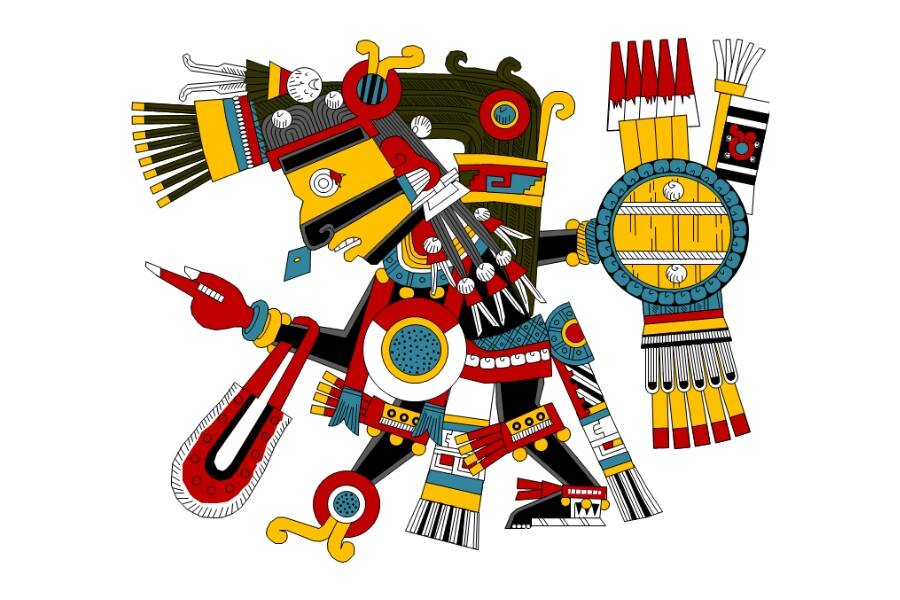
Public AreaTezcatlipoca was the Aztec god of the night time sky and the patron deity of warriors.
Like most gods within the Aztec pantheon, Tezcatlipoca is troublesome to outline in a succinct method. He was a multifaceted determine, embodying a wide range of ideas starting from the night time sky to battle and sorcery. His animal counterpart, or nagual, was the jaguar, thought-about by the Aztecs to be a strong and mystical creature with connections to the Underworld.
The Aztecs revered jaguars, and elite warriors even adorned themselves in jaguar pelts as a approach of imbuing themselves with the animals’ power and ferocity in battle. It is smart then that Tezcatlipoca was held in excessive regard by the Aztec folks. He was a creator god, the bringer of excellent and evil, and the patron deity of warriors.
He was thought-about to be probably the most essential gods within the Aztec pantheon, and he was held in equal esteem as his brothers Quetzalcoatl, Huitzilopochtli, and Xipe Totec. Tezcatlipoca options in lots of Aztec myths, and his worship was widespread throughout Mesoamerica.
After all, a lot of this worship concerned human sacrifice.
Tezcatlipoca’s Position In The Aztec Creation Delusion
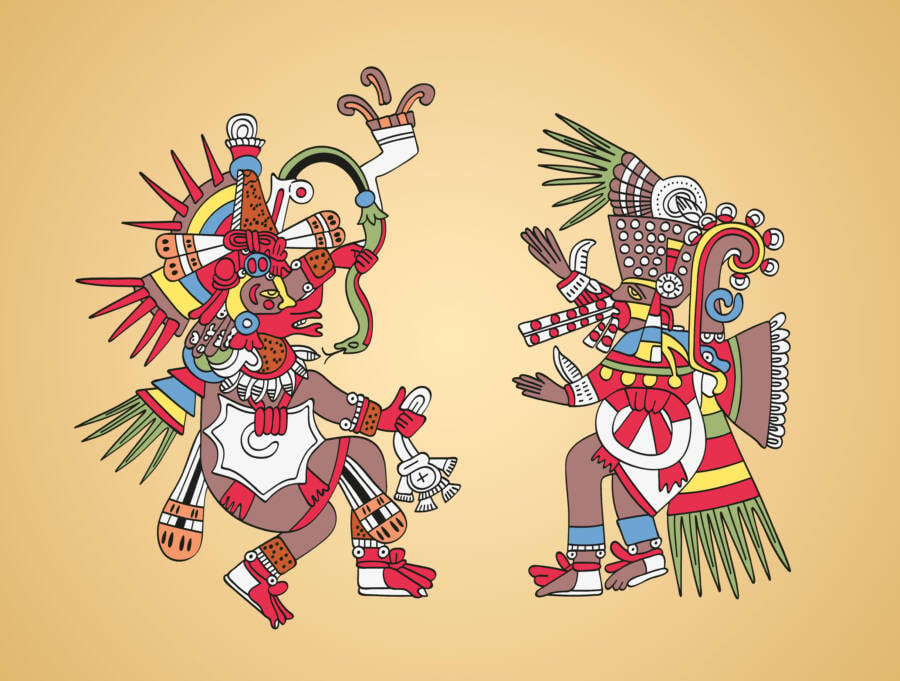
Peter Hermes Furian / Alamy Inventory PhotographQuetzalcoatl, the feathered serpent deity, and Tezcatlipoca, the jaguar god.
Based on legend, Tezcatlipoca was instrumental within the creation of the world. He was considered one of 4 youngsters born to the duo of primordial gods referred to as Ometecuhtli and Omecihuatl. Together with Quetzalcoatl, Xipe Totec, and Huitzilopochtli, he ushered within the cycle of the 5 Suns that introduced in regards to the formation, destruction, and reconstruction of the mortal world.
Tezcatlipoca was typically portrayed as Quetzalcoatl’s rival. At first, the 2 brothers labored collectively to create the world. An enormous, crocodile-like creature referred to as Cipactli sat astride the ocean, demanding flesh to feast upon. Absolutely, the gods felt, humanity couldn’t survive in a world the place such an animal existed.
Quetzalcoatl and Tezcatlipoca reworked into large snakes, attacking and dismembering Cipactli’s physique, from which the Earth and sky emerged. Her hair and pores and skin turned timber, crops, and flowers, whereas her tooth fashioned the mountains and her eyes turned caves.
Tezcatlipoca dominated over this new world in the course of the interval of the First Solar, referred to as Nahui Ocēlōtl, or the Jaguar Solar. Throughout this era, the world was inhabited by a race of giants who ultimately displeased the gods. Quickly, a battle arose between Tezcatlipoca and Quetzalcoatl, and Quetzalcoatl in the end struck Tezcatlipoca down from the sky.
Tezcatlipoca retaliated by sending jaguars to devour the giants, bringing the period to a sudden, violent finish.
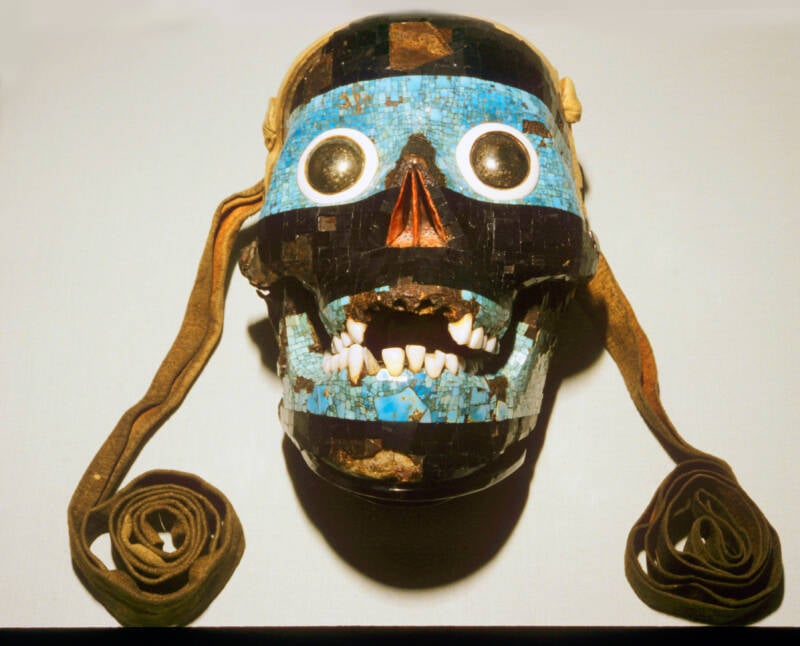
Historic Artwork and Structure / Alamy Inventory PhotographA masks depicting the human cranium of Tezcatlipoca.
Through the Second Solar, Quetzalcoatl changed his fallen brother as the brand new Solar. Nevertheless, Tezcatlipoca wouldn’t abide by this riot. He turned all people on Earth into monkeys, which had been then swept away by Quetzalcoatl in an incredible hurricane, bringing a near the second age.
The Third Solar noticed the ascension of the god Tlaloc. Nevertheless, his rule was additionally disrupted by Tezcatlipoca. As soon as once more, searching for to sow chaos, the god seduced Tlaloc’s spouse, leaving Tlaloc in a state of deep grief. Throughout his mourning, he uncared for his duties, withholding rain from the world and bringing about an incredible drought.
Tlaloc lastly summoned rain, however it was made of fireplace and destroyed the world and its inhabitants.
Tlalocs new spouse, Chalchiuhtlicue, turned the Fourth Solar. Although the goddess of water was seen as a form ruler, Tezcatlipoca as soon as once more intervened, accusing her of merely feigning her kindness to deceive humanity. Harm by Tezcatlipoca’s remarks, Chalchiuhtlicue wept for 52 years, flooding the world and turning people into fish.
Two survivors of this flood safely made it to land and constructed a fireplace to prepare dinner themselves some fish. Nevertheless, the smoke from the hearth disturbed the celebrities within the sky above, they usually complained to Tezcatlipoca. In response, the deity decapitated the pair and reattached their heads to their bottoms, thus creating canine.
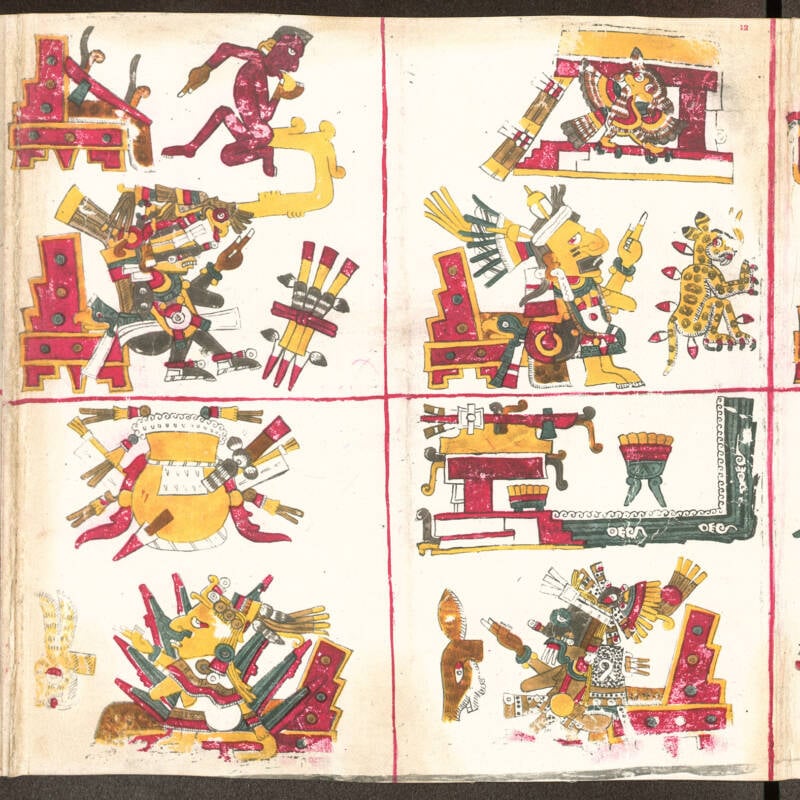
Public AreaTezcatlipoca (higher left panel) as portrayed within the Sixteenth-century Codex Borgia.
Tezcatlipoca considerably redeemed himself in the course of the Fifth Solar, nevertheless. This ultimate period — the present one, in keeping with the parable — started with the sacrifice of the gods Nanahuatzin (or, in some variations of the story, Xolotl) and Tecciztecatl, who turned the Solar and Moon respectively. However the Solar and Moon remained immobile.
To set them in movement, lots of the gods sacrificed their very own blood, and in some variations of the parable, Tezcatlipoca was the primary deity to supply himself up.
Naturally, there are lots of variations to those legends, however every constantly acknowledges the pivotal function Tezcatlipoca performed within the formation — and destruction — of the worlds. His significance didn’t go unnoticed by the Aztec folks.
How Tezcatlipoca’s Cult Celebrated The God Of The Evening Sky
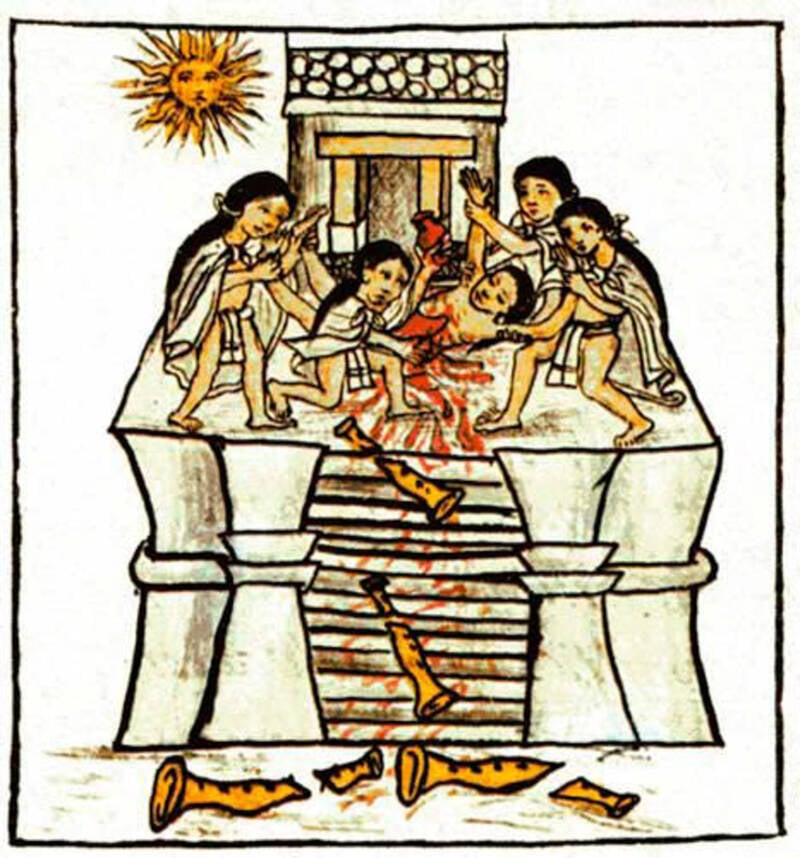
Historic Pictures / Alamy Inventory PhotographA younger man being sacrificed to Tezcatlipoca.
Worship of Tezcatlipoca and different Aztec gods was typically a bit complicated. Legends counsel that every of those gods was their very own distinct deity, although many had been typically siblings and, in lots of circumstances, thought-about “twins” of one other deity. Different variations of the legends, nevertheless, cite a single, supreme deity who has a number of “manifestations” that tackle completely different kinds.
Some Mesoamerican cultures regarded Tezcatlipoca as this supreme all-powerful deity. Based on the World Historical past Encyclopedia, these manifestations had been referred to as Black Tezcatlipoca, Blue Tezcatlipoca, Pink Tezcatlipoca, and White Tezcatlipoca.
Nevertheless, for the sake of readability, these supposed manifestations may be known as different gods. Black Tezcatlipoca, or the “Smoking Mirror,” is often attribute of the person god Tezcatlipoca. Blue Tezcatlipoca is extra generally known as Huitzilopochtli. Pink Tezcatlipoca, or the “Flayed One,” is most frequently referred to as Xipe Totec. And White Tezcatlipoca, the “Plumed Serpent,” could be seen as Quetzalcoatl.
It’s essential to acknowledge this unusual twin affiliation, although, because it explains a lot about how Tezcatlipoca was worshipped.
The only most important ritual devoted to Tezcatlipoca was the Tóxcatl pageant, held in the course of the fifth month of the Aztec calendar. Preparations for the pageant started a yr upfront with the number of a younger man, typically a captured warrior, who would impersonate Tezcatlipoca. Generally known as the ixiptla, this particular person was seen as a bodily good vessel for the god and handled as such.
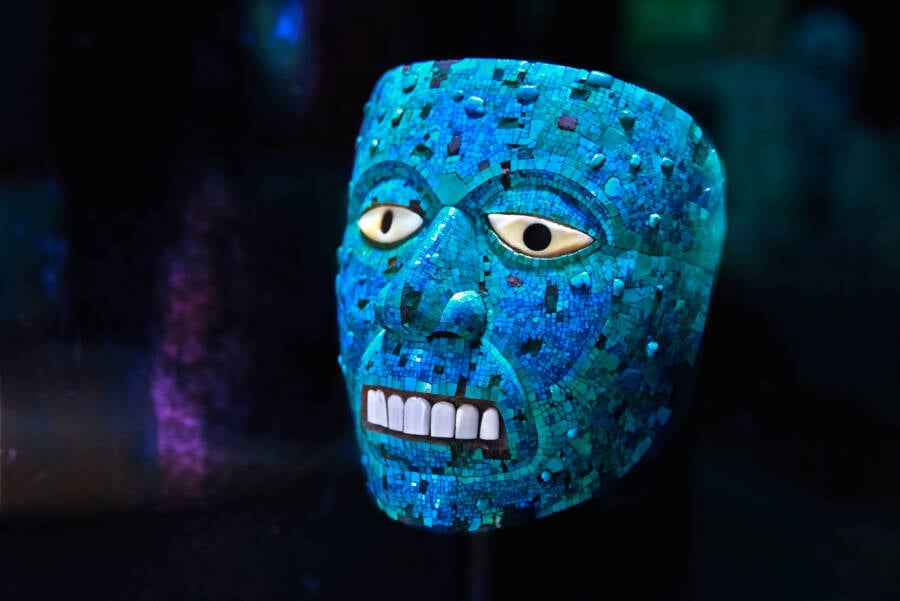
Rik Hamilton / Alamy Inventory PhotographA mosaic masks of the god Tezcatlipoca.
For a yr, the ixiptla lived in luxurious, adorned in positive clothes and jewellery and accompanied by attendants. The folks, in the meantime, worshipped him because the god incarnate. He was additionally married to 4 younger girls representing goddesses.
Then, on the day of the pageant, the proceedings took a macabre flip. The ixiptla would ascend the steps of a temple devoted to Tezcatlipoca to be sacrificed by clergymen, who eliminated his coronary heart utilizing an obsidian knife. Although grisly, the sacrifice was thought-about an incredible honor.
Nevertheless, the Tóxcatl pageant would additionally grow to be a part of one thing far darker within the Sixteenth century: the Tóxcatl Bloodbath.
The Tóxcatl Bloodbath And The Spanish Conquest Of The Aztec Empire
Given how essential the Tóxcatl pageant was to the Aztec folks, it naturally drew loads of consideration from the Spaniards as they started to overcome a lot of the empire. Seeing the pageant and its excessive variety of revelers as a possibility to additional their very own pursuits, the Spaniards struck.
However first, some background: In November 1519, Spanish conquistador Hernán Cortés and his forces entered Tenochtitlan, the place they had been obtained by Emperor Montezuma II. Nevertheless, tensions rapidly arose when the Spaniards took Montezuma hostage with the categorical curiosity of controlling the Aztec management. Then, in April 1520, Pánfilo de Narváez launched his personal expedition within the Aztec kingdom, forcing Cortés to go away Tenochtitlan underneath the command of his deputy Pedro de Alvarado.
In the meantime, the Aztecs started to make preparations for the Tóxcatl pageant with permission from Alvarado. Sadly, his intentions weren’t pure.
On Could 22, 1520, Alvarado, fearing an rebellion, mobilized his forces and massacred the unarmed individuals gathered within the Nice Temple of Tenochtitlan. Spanish troopers blocked the exits and slaughtered quite a few Aztec nobles, clergymen, and warriors.
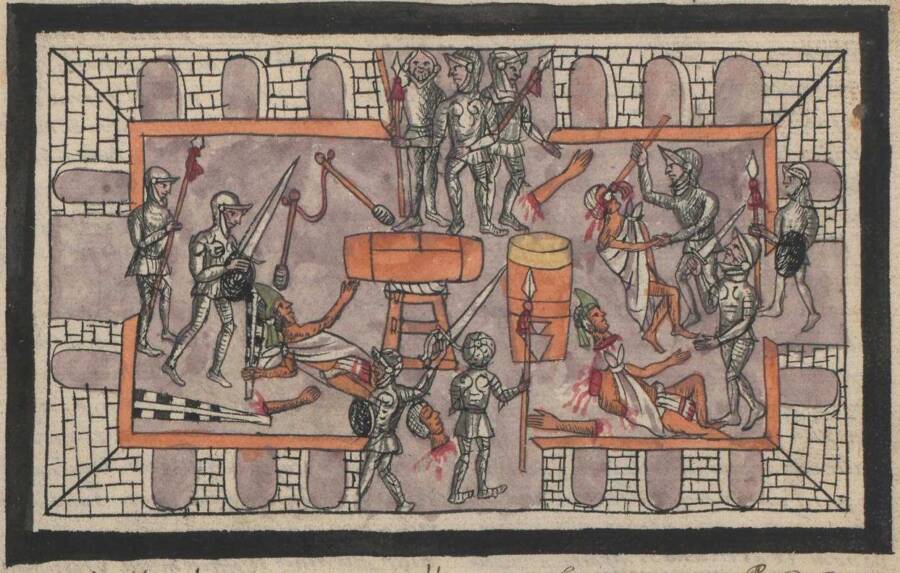
Public AreaAn illustration of the Tóxcatl Bloodbath.
Based on the Getty Museum, there are contrasting data of the occasion, with the Spaniards claiming they acted in self-defense — although, based mostly on the conquistadors’ report, it’s extra seemingly they had been the instigators.
In both case, information of the bloodbath unfold rapidly all through the Aztec empire, inciting widespread outrage. Ultimately, that outrage turned a full-scale riot in opposition to the Spanish occupiers. When Cortés returned, he discovered town in turmoil and urged Montezuma to handle his folks and quell the rebellion.
The folks greeted Montezuma with hostility, and he died quickly after underneath unclear circumstances. The escalating violence, nevertheless, pressured the Spaniards to flee Tenochtitlan on June 30, 1520, an occasion now referred to as “La Noche Triste,” or the Evening of Sorrows.
The bloodbath successfully shattered any remaining belief between the Aztecs and the Spaniards, and although they efficiently pressured the Spaniards out of town then, the conquerers returned a yr later and destroyed Tenochtitlan and its folks. Thus, the Aztec empire — and the worship of Tezcatlipoca — got here to an finish.
After studying in regards to the Aztec god Tezcatlipoca, study all about Mictlantecuhtli, the Aztec god of the Underworld. Then, see contained in the Templo Mayor, the Aztec temple of skulls that terrified Spanish conquistadors.

